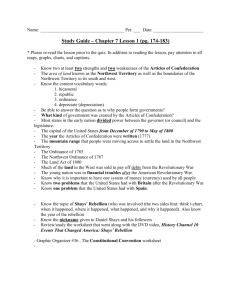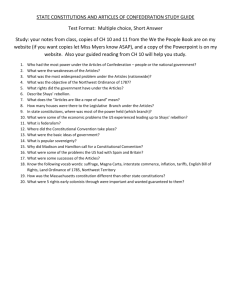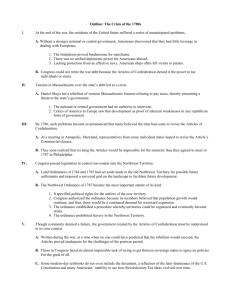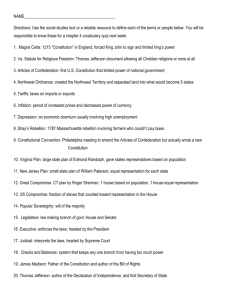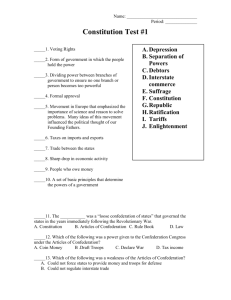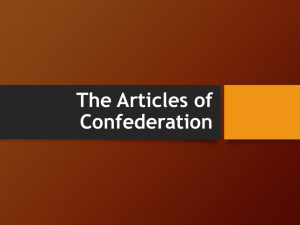Name: Per. ___ Date: Teacher Notes and General Study Guide for
advertisement
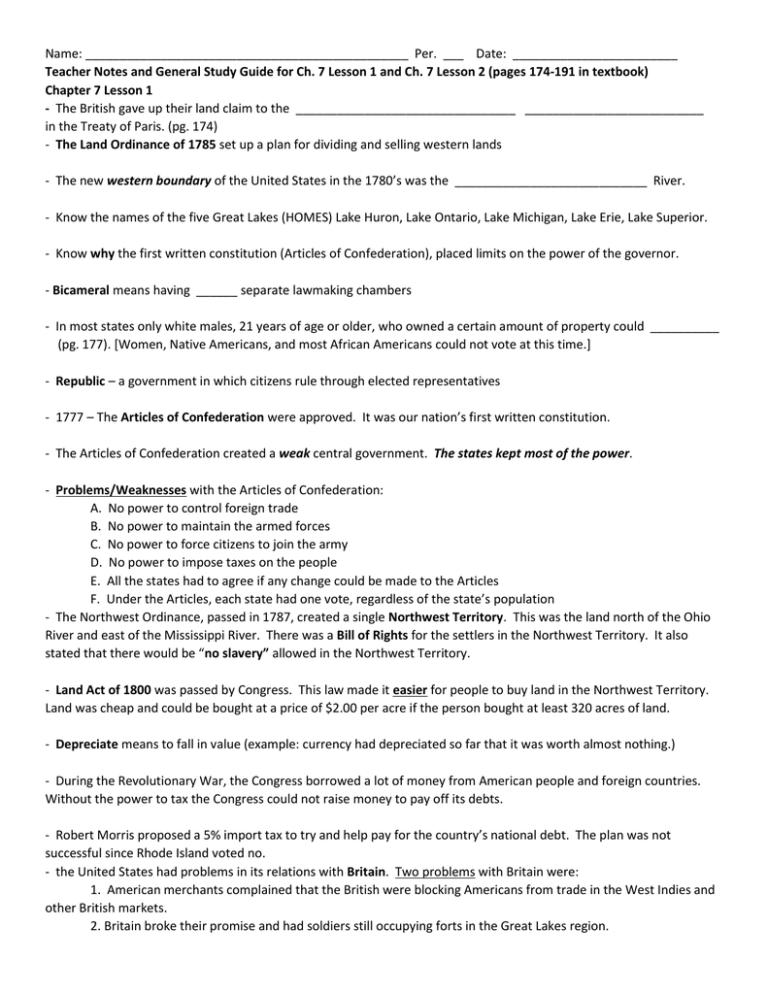
Name: _______________________________________________ Per. ___ Date: ________________________ Teacher Notes and General Study Guide for Ch. 7 Lesson 1 and Ch. 7 Lesson 2 (pages 174-191 in textbook) Chapter 7 Lesson 1 - The British gave up their land claim to the ________________________________ __________________________ in the Treaty of Paris. (pg. 174) - The Land Ordinance of 1785 set up a plan for dividing and selling western lands - The new western boundary of the United States in the 1780’s was the ____________________________ River. - Know the names of the five Great Lakes (HOMES) Lake Huron, Lake Ontario, Lake Michigan, Lake Erie, Lake Superior. - Know why the first written constitution (Articles of Confederation), placed limits on the power of the governor. - Bicameral means having ______ separate lawmaking chambers - In most states only white males, 21 years of age or older, who owned a certain amount of property could __________ (pg. 177). [Women, Native Americans, and most African Americans could not vote at this time.] - Republic – a government in which citizens rule through elected representatives - 1777 – The Articles of Confederation were approved. It was our nation’s first written constitution. - The Articles of Confederation created a weak central government. The states kept most of the power. - Problems/Weaknesses with the Articles of Confederation: A. No power to control foreign trade B. No power to maintain the armed forces C. No power to force citizens to join the army D. No power to impose taxes on the people E. All the states had to agree if any change could be made to the Articles F. Under the Articles, each state had one vote, regardless of the state’s population - The Northwest Ordinance, passed in 1787, created a single Northwest Territory. This was the land north of the Ohio River and east of the Mississippi River. There was a Bill of Rights for the settlers in the Northwest Territory. It also stated that there would be “no slavery” allowed in the Northwest Territory. - Land Act of 1800 was passed by Congress. This law made it easier for people to buy land in the Northwest Territory. Land was cheap and could be bought at a price of $2.00 per acre if the person bought at least 320 acres of land. - Depreciate means to fall in value (example: currency had depreciated so far that it was worth almost nothing.) - During the Revolutionary War, the Congress borrowed a lot of money from American people and foreign countries. Without the power to tax the Congress could not raise money to pay off its debts. - Robert Morris proposed a 5% import tax to try and help pay for the country’s national debt. The plan was not successful since Rhode Island voted no. - the United States had problems in its relations with Britain. Two problems with Britain were: 1. American merchants complained that the British were blocking Americans from trade in the West Indies and other British markets. 2. Britain broke their promise and had soldiers still occupying forts in the Great Lakes region. - the United States had problems with Spain. One problem with Spain was: 1. Spain closed the Mississippi River to American shipping because Spain wanted to stop U.S. expansion into Spanish territory. This action hurt American farmers who used the river for transportation and trade. Chapter 7 Lesson 2 - Depression is a period of time when economic activity slows down and unemployment increases. - In Western Massachusetts, farmers were having financial trouble. Since they could not pay their taxes and debts, many had their farms and land seized (taken from them) and they were thrown into jail. - Daniel Shays, a hero from the Revolutionary War, organized a rebellion against the government of Massachusetts. The farmers shut down courts in the western part of the state. The uprising did not last long. However, the rebellion scared many Americans. Concern was growing that the national government could not handle unrest and prevent violence. Shays’ Rebellion revealed the weaknesses in the Articles of Confederation. - the issue of slavery was beginning to be questioned in the United States. In the North, people began working to end slavery. Slavery was not a major source of labor in the North. In the South, slavery was part of their way of life and important to the southern economy. The plantation depended on slave labor. - The Constitutional Convention was held in in Philadelphia, Pennsylvania in 1787. - George Washington came out of retirement to lead the convention. - Native Americans, African Americans, and women were not represented at the Constitutional Convention. These groups were not considered part of the political process at this time. (Racism and Sexism existed at this time) - the Virginia Plan: 1. Called for a strong national government 2. Created a government with three branches 3. Created a government with a two-house (bicameral) legislature, 4. Created a government with a chief executive 5. Created a government with a court system the New Jersey Plan: 1. Called for a government stronger than the Articles, but less powerful government than the Virginia Plan. 2. Created a government with a one-house legislature 3. Equal representation from all the states - The Great Compromise: (offered by Roger Sherman) To settle the disagreement on representation in the new government between the small states and the large states. Sherman’s compromise said that in the upper house – the Senate each state would have two members. That means the states would have equal representation. In the lower house, - the House of Representatives, the number of seats for each state would vary based on the state’s population. Larger states would have more representation. The Three-Fifths Compromise Delegates from the South and North disagree on whether and how to count each state’s enslaved population. Northern states did not believe slaves should count in determining a states population. In the South, the Southern states wanted slaves to be counted in determining a given state’s population. A compromise was made that said every five slaves would count as three persons in the state’s population total.
